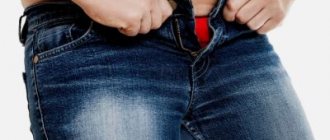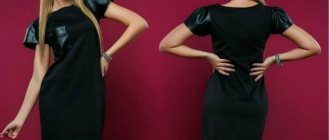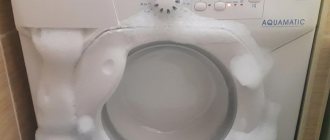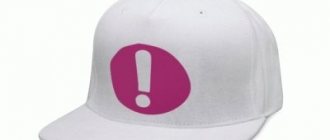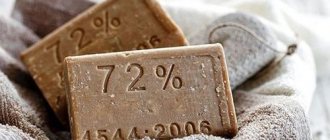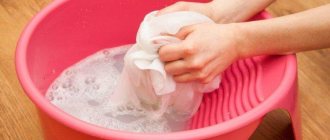Acrylic is a synthetic material. Acrylic fiber has great strength and dyes well. During washing, the paint is not washed out of it, thanks to which such products retain their color for a long time. They are wear-resistant, not susceptible to mold, not damaged by moths, and do not wrinkle.
At the same time, there are a number of disadvantages that should be taken into account during operation and washing:
- acrylic fabrics do not absorb moisture well;
- easily form greasy stains;
- During washing, the item may become deformed, stretched, or form pills.
Therefore, many people believe that machine washing of these products is impossible. Actually this is not true. To avoid negative consequences and not spoil the item, you need to apply certain rules and know how to wash acrylic.
How to wash acrylic in a washing machine
If the material consists entirely of acrylic, it can be machine washed. To prevent the fabric from deforming and rolling, a number of conditions must be met:
- Wash acrylic items separately from other clothes. The washing machine drum should be no more than half full.
- Use a zippered mesh bag.
- Soak the item in soapy water for 10 minutes before washing in the machine.
- On light-colored items, wash the collar and cuffs with soap in advance.
- Remove difficult stains with stain remover or laundry soap before washing.
- Fasten zippers and buttons, if present.
- Turn the item inside out.
Before loading an item into the washing machine, read the information on its label. It must contain permissible temperature conditions and other recommendations for caring for clothing.
Use of bleaches
On acrylic, as on other fabrics, various stubborn stains form, including from coffee, tea, varnish, and soil. To solve the problem, you can use bleach or liquids containing it.
But there are nuances, knowing about which you can keep the thing in its original form:
- Bleach should not be used to remove stains on dark fabric.
- Acrylic clothing should not be boiled.
- Before the procedure, you should wash a piece of material with a chlorine-containing product in order to see the reaction to bleach (a test piece is usually sewn on the wrong side of the product).
Vanish "Oxi Action. Crystal white."
It is the leader among preparations for bleaching gray clothes. In addition to this function, it also copes well with difficult stains on light-colored clothes. Surfactants, phosphonates and hexyloric aldehyde contained in the gel act on dirt molecules, breaking down and washing them away from the fabric fibers.
The method of application is quite simple: you just need to soak the clothes in warm water with the addition of one cap of the product and leave it for 30-40 minutes. And then wash it in a washing machine.
If there is a stain that is difficult to remove, you should first fill it with Vanish and let the liquid absorb for 20-30 minutes, and then wash the item by hand or by machine.
Mitsuei
To refresh colored clothes, this Japanese product is best suited. This is a concentrated oxygen bleach for fabrics of variegated colors, the substances of which actively penetrate deep fibers and wash out dirt. Despite this, the product does not damage the pigment, has an antibacterial effect and has a pleasant aroma. It also has stain-removing properties, so it can be used to clean even the most stubborn stains.
The method of application is to soak acrylic items in warm water with the addition of 20 ml of product. Finally, the product is washed with special gels.
Dr.Breckmann
One of the most difficult stains to remove from acrylic fabrics is greasy stains. Not all means cope with it. A spray product will help you solve this problem, thanks to which tiny droplets of fat solvent are absorbed deep into the fabric, soaking stains and removing them from the material. In this case, the paint of the canvas is not damaged under the influence of the product.
To clean dirt, as well as to bleach the product, spray the liquid onto the problem area or onto the entire surface of the item, and then leave for 20-30 minutes. After this, the fabric is washed by hand or in a machine.
Clean Home
Suitable for removing yellowness from children's clothing. Hydrogen peroxide contained in the liquid dissolves plaque from the surface of the material, thereby giving the fabric dazzling whiteness.
The product does not contain chlorine, dyes or preservatives, so it can be used for washing clothes for newborns.
To whiten things with the product, it should be added to the conditioner compartment. To achieve the best effect, it is used with powder.
Attention: be sure to read the packaging for more detailed information about the methods of use and doses of each product.
Detergents
Although it is not forbidden to wash acrylic with powder, it is better not to do this. Powder particles may not dissolve completely and settle on the acrylic fibers, causing the item to become rough and require a long rinse. And any mechanical impact only harms acrylic.
A liquid detergent labeled “for acrylic fabric” is best for washing such items.
Use fabric softener when washing. It fluffs up fibers and removes static electricity.
Product Features
Acrylic is a 100% synthetic fiber. This is the name of an artificial substitute for natural wool, which costs much less. Products made from acrylic have a very resistant color, practically do not wrinkle or deform even during machine washing.
Caring for synthetic knitted items is quite simple, you just need to follow some recommendations:
- You can wash such things only in cool water no higher than +40 degrees;
- Even the use of regular washing powder is allowed, although it is better to give preference to gels for washing delicate fabrics;
- Acrylic products should not be rubbed too hard during washing, as the hinges may be damaged;
- squeeze out the acrylic very carefully, trying not to twist the thing too much. The machine should be set to minimum spin speed.
Expert opinion
Kristina Samokhina
Experienced housewife.
The use of aggressive bleaching compounds is prohibited. Use regular powder for colored laundry if you don’t have a special product on hand.
Sweaters and sweaters made of acrylic are most often worn every day on weekdays. Due to frequent wearing, clothes quickly become dirty. Products have to be washed frequently, almost every week. When washing, it is advisable to add conditioner during rinsing to make the jacket soft.
Very often, acrylic thread is mixed with natural wool in production. In this case, the item can only be washed with special wool powders. When machine washing, select a delicate wash cycle.
How to wash by hand
If the fabric contains natural fibers in addition to acrylic, it can only be washed by hand. You need to fill a basin with water at a temperature of 25-30 degrees and dissolve grated soap in it. Immerse the clothes in water and carefully wash the collar and cuffs. Then leave the item in the water for 10-15 minutes. When finished, rinse the clothes 2-3 times in water of the same temperature.
During the last rinse, you need to add hair rinse or conditioner.
Removing contaminants
But, before you start washing the product in powder, you need to carefully inspect it for stains, and, if any are found, remove them. To do this, soak the clothes in cold water and then remove the stain. Fresh stains are much easier to remove, so it’s better not to delay removing stains.
You can remove stains from acrylic thread with regular brown washing soap. To do this, lather the stained area thickly, leave the item for half an hour, and then gently rub the stain with your hands.
How to dry things after washing
Acrylic items are lightly squeezed in your hands so that the water drains from them, then placed on the dryer. If it is not there, then spread a large towel on a horizontal surface. Place the item on it and blot it slightly. The towel is changed, and the clothes are carefully straightened to avoid creases.
When drying acrylic items, the following is prohibited:
- hang on a clothesline.
- put on the battery.
- hang on hangers.
- leave near a heater or in direct sunlight.
High temperatures are detrimental to acrylic. The fabric should not be blow-dried or ironed.
Drying and ironing
This procedure is the final stage of washing clothes made from acrylic thread. The final look of the outfit depends on it.
Drying has its own nuances:
- the product must be positioned horizontally;
- do not hang acrylic on ropes or heating radiators;
- It is recommended to place a thin cotton fabric under the product;
- Drying should be done naturally at room temperature.
Important: ironing synthetic items is strictly prohibited. This can only be done to correct tissue deformation.
Acrylic clothing has many benefits. And if you are ready to close your eyes to small nuances when washing products, then such things will become your favorite.
How to remove stains
By washing a down jacket, even in an automatic machine, it is sometimes impossible to solve the typical problems of its contamination: darkened edges of the sleeves, a soiled collar, dirty edges of pockets and the sides of the product. In addition to typical stains, various specific stains may also occur: from food and drinks, traces of blood, oil and greasy stains on fabric. And the presence of yellow stains on a white product is a common and difficult problem to solve. First you need to learn how to remove each of the stains. More often this is done by treating the fabric and soaking it before the main washing process.
Fat
When starting to wash a down jacket yourself, you can achieve the best result only through careful preparation: initial inspection and processing of the product. This type of winter outerwear is very difficult to handle and use, but all this is covered by its heat-saving and hypoallergenic properties.
Several familiar techniques can save any item from greasy stains: using mustard powder, liquid dishwashing detergent, salt or even shaving foam. It is better not to take risks on white material with mustard powder due to its coloring pigment. But dish degreaser and salt will handle the stain just fine.
The powder must be dissolved in warm water until it reaches a mushy consistency. Place the mixture on the site of contamination. Hot water should absolutely not be used; feather fibers will quickly absorb the mustard pigment and risk deformation. Foam and degreaser should be applied without first diluting anything, just like salt. Salt particles absorb contaminants through diffusion. It is best to replace them several times until the salt remains clean and white and the stain is discolored.
Shiny
If a greasy stain has gone unnoticed since last season, it will be more difficult to remove it, since in order to properly wash a down jacket, you also need to act delicately. A specialized stain remover for wool and fluff, as well as delicate fabrics, will help remove old greasy stains. Typically, these products have a liquid consistency and are applied topically or added to laundry detergent. It is not advisable to use powdered stain removers. After them, the clothes will have a long recovery from stains and a whitish tint.
Ink
It would seem impossible to ruin washed clothes with stains. But even worse would be to discover an ink stain on a white down jacket before putting it in the washing machine. If such contamination has recently appeared on your jacket, it will be easy and quick to remove.
Take a sponge soaked in alcohol and gently wipe the stained area on the fabric. After this, the final treatment will be wiping with a damp cloth. In the car, after these manipulations, the down jacket does not risk becoming stained with ink. The older the ink blot on your outerwear, the more effort it will take to remove it.
Glycerin, milk, heated whey of dairy products and hydrogen peroxide are suitable for treating ink that has become embedded in the fabric. To avoid further damage to the material, try applying peroxide or stain remover somewhere inconspicuous, on the edge or at the seam junction, for example, inside the garment on the lining side.
Having finally made sure that the reagents do not harm the structure of the fabric and its pigment, feel free to proceed to cleaning the stain. Stain removers and bleaches will do the job well. Chlorine-based products are best avoided. They guarantee that the item will be washed without streaks.
What are the benefits of acrylic and what are its disadvantages?
If you are interested in learning about how to properly wash acrylic, you will need some knowledge of its features:
- A fabric such as acrylic is quite soft and gentle to the touch.
- This material can dry fairly quickly after it has been wetted.
- It has a low level of hygroscopicity. It almost does not absorb moisture. This allows such things to hardly deteriorate after washing, but it also reduces the hygiene of the material.
- Clothing made from acrylic stretches and can roll down when worn.
- If acrylic is not properly cared for, its color may fade over time.
- This fabric is capable of absorbing fat.
- Acrylic does not like high temperatures. Hot water makes it rough, it loses its softness, and the thing loses its shape.
We remove different types of stains
On shirts and T-shirts, yellow spots most often appear in the armpit area. Also, traces of drinks often remain on things. Often there is a need to wash things from rust and grease stains. Contamination from pens and felt-tip pens is especially corrosive.
Yellow under the arms
To remove traces of sweat from things, it is recommended to use alcohol. To do this you need:
- take 96% alcohol and dilute it in water - just dilute 120 g of alcohol in 220 g of water;
- soak a cotton pad in the solution;
- apply it to the yellow spot around the entire perimeter;
- wait a couple of hours;
- wash the product.
It is allowed to add a small spoon of salt to the alcohol solution.
From drinks
To remove traces of tea from things, it is recommended to use vinegar.
- Take a large spoon of vinegar and mix it with ½ small spoon of dish soap.
- Stir the mixture.
- Treat the stain with it.
- Wait 15 minutes.
- Rinse off with tap water.
Coffee stains are best removed with a mixture based on vinegar, washing powder, grated laundry soap and warm water.
One small spoon of each component is enough. All of them are mixed and applied to the dirt. The mixture is washed off after 20 minutes.
Wine stains can be removed with ammonia
From rust
Such stains should be removed with lemon juice.
To do this you need:
- pour 5 large spoons of lemon juice and the same amount of cold water into a wide glass;
- dip clothes into the solution at the place where there is a rusty stain;
- wait 15 minutes.
At the end, you need to rinse the item under running cold water and wash it with powder.
From fat
To get rid of grease stains, use salt and laundry soap:
- Soak the greasy stain with a paper towel.
- Sprinkle salt generously on it and leave for 5 minutes.
- The stain is rubbed with laundry soap and covered with a plastic bag.
- The item is left for half a day.
After processing, the product is washed in a machine or by hand.
From pen and felt-tip pen
Products for removing marks from pens and felt-tip pens are selected taking into account the basis of these writing instruments:
- If the pen or felt-tip pen is water-based, then stains from them can be washed off with laundry soap or ammonia.
Just rub the item with a bar of soap, wait 15 minutes and rinse with cold water. If ammonia is used, then use a cotton pad soaked in it to thoroughly treat the stain, and then rinse the product with cold water. - If a pen or felt-tip pen has a fatty base, then stains from them can be removed with vegetable oil. The item is wiped with a cotton swab dipped in it. After this, the product must be washed with powder.
- Stains from pens and felt-tip pens, which are based on paint filler, can be washed off only with solvents. It is necessary to treat the contamination with a cotton swab soaked in acetone. This should only be done for a couple of minutes. Then the product must be washed.
Traces from an alcohol felt-tip pen are removed with a mixture of medical alcohol and grated laundry soap.
Both components are mixed to a paste. The paste is applied to the stain and rubbed in with a toothbrush. After this, the clothes need to be washed with powder.
Is it possible to restore a shrunken sweater?
To prevent a synthetic cardigan from shrinking, you should strictly observe the washing temperature, not exceed its maximum permissible value, and also select a gentle automatic mode. But if the sweater does shrink, there is no need to be upset; in most cases, you can return the shape of your favorite item.
Re-soaking the acrylic in cold water with the addition of a softening conditioner-rinse aid can help correct the misunderstanding. The jacket should be immersed in a basin for 15-20 minutes, then wrapped in a sheet or towel, and gently squeezed out. Then the sweater needs to be laid out on a horizontal surface and, with gentle movements, stretched evenly in all directions. While the cardigan is drying, it is necessary to stretch the material every half hour.
If possible, it is better to put on a damp, shrunken sweater and walk around in it until the item dries.
There is another, more sophisticated way to give acrylic clothing its original shape. It is necessary to prepare a solution: add shavings of laundry soap, 15 ml of turpentine and 15 ml of ammonia to the water, mix everything well. The sweater is immersed in this liquid for a day. After soaking, the cardigan is stretched and dried on the countertop, placing a terry towel under it to absorb excess moisture.
Machine
Acrylic can also be washed in a washing machine, but only if the product does not contain decorative elements in the form of beads, rhinestones, chains and sequins. Basic rules for machine washing:
- prepare the product: check the pockets, fasten the buttons and zippers, and also turn it inside out;
- Do not wash acrylic with other materials;
- before washing, the item must be placed in a special bag that will protect the fibers from excessive friction;
- acceptable modes are “Delicate wash”, “Hand”, “Synthetics”, “Wool”;
- you can set the double rinse mode;
- It is advisable to exclude spinning and automatic drying.
Characteristics and features of the material
An artificial material such as acrylic is very light and soft in texture, but at the same time its threads are quite strong, which makes it possible to create products that retain heat.
Items made from this fiber practically do not wrinkle, have good wear resistance and dry quickly after washing. Acrylic sweaters have a rich range of colors, as this material takes paint well and holds any shade for a long time without fading in the sun. The big advantage is that acrylic, compared to natural wool, does not shrink after washing in hot water. But, in addition to the advantages, there are also disadvantages, although there are not many of them. An acrylic sweater is prone to pilling, it can become electrified, and when washed in too hot water, the fibers stretch, resulting in the product being deformed.
The best bleaching methods to keep your laundry snow-white
To restore the snow-whiteness of things, you can use several methods to solve the problem:
- use of folk recipes;
- use of household bleaching agents;
- boiling.
The bleaching of children's clothes deserves special mention. For these purposes, boiling with laundry soap can be used (if the product can be treated this way) or the use of special children's bleaches, for example.
Each bleaching method has limitations that must be taken into account in order not to spoil the product.
Boiling
Using boiling can not only whiten things, but also remove dirt and refresh fabric. It may be allowed to expose only products made of dense cotton or linen fabrics that do not have a complex cut, decoration or inserts from other materials.
For boiling you will need:
- large enameled container (about 10 liters in volume);
- detergent (laundry soap - 1-2 pieces);
- device for mixing things.
It is not advisable to use galvanized and aluminum pans for boiling, since as a result of the chemical reaction of the detergent with the metal, difficult-to-remove stains may appear on the fabric.
Also, when washing, you should not replace laundry soap with washing powder - during the boiling process, fumes harmful to humans will be released into the air. In addition, most washing powders are not designed for heating above +95ºС.
Procedure:
- Grate laundry soap.
- Pour water into a container.
- Place the container on the fire.
- Add grated soap.
- Stir until completely dissolved.
- Place the laundry in the water.
- Stirring occasionally, bring the cleaning solution to a boil.
- Reduce heat.
- Continuing to stir things, boil them for 1-1.5 hours.
- Leave things to cool.
- After washing, rinse and dry.
To enhance the effectiveness of boiling, you can add 2 tbsp to the soap solution. l. hydrogen peroxide. An alternative option is to add 10 tbsp. l. soda
It is advisable to use the container used for boiling things only for household purposes, and not for food.
Use of household chemicals
In addition to chlorine-containing bleaches, modern housewives have products in their arsenal that act gently without damaging the fabric. They can be used for washing, and can also be added to washing powder as an addition to increase washing efficiency.
These bleaches include:
- "Vanish";
- "BOS plus" and others.
Regular use of bleach will keep things white.
Folk recipes
A simple way to make bed linen and T-shirts white is to add 1 tbsp. l. soda into the washing powder compartment of the machine. You can also add soda to the powder during manual processing.
Soaking in a solution with ammonia will also help to whiten things:
- Combine 2 tbsp in a bowl. l. ammonia and the same amount of soda.
- Mix.
- Pour into a basin.
- Fill with water (5 l.).
- Mix.
- Place the laundry in the basin.
- Leave for a couple of hours.
- Rinse.
- Wash as usual.
Equipment and care products
- Equipment
- Facilities
Which washing machine to choose
How to iron with less effort and more comfort
How to quickly and easily iron anything
How to save time and quickly dry clothes and bedding
Review of classic, travel, wireless, smart and professional models
The best options in terms of quality, reliability and price
Rating of the best floor and ceiling models
The best dryers of ceiling, floor, wall types and models that can be installed on a bathtub or radiator
Choosing a product for adult and children's underwear
The best products for white, colored and children's underwear
Top 15 products for colored, white and children's underwear
Choose an antibacterial, biodegradable and hypoallergenic laundry detergent
Choosing the best laundry detergent
Choosing sheets for white, colored and children's linen
Top 15 best positions for washing adult and children's clothes
Rating of detergents for white and colored laundry
How to keep items made from natural fabrics clean and in shape
Choosing a product to quickly remove stains of any complexity
Properties of acrylic
Acrylic has a second name - nitron. These are completely synthetic fibers, durable and hold paint well. They are used to make fleecy sweaters (“grass”), scarves, carpets and blankets.
Things made from acrylic fiber have a number of pros and cons:
- They are afraid of high temperatures.
- They warm well.
- Do not lose color.
- They tend to form pellets.
- May become deformed if improperly washed and dried.
- Quickly absorbs greasy stains.
- They don't wrinkle.
- not afraid of insects and mold.
- Soft and pleasant to the touch.
- Wear-resistant.
- Static electricity accumulates.
- They do not absorb moisture well.
Some clothing manufacturers add cotton or wool fibers to nitron. The admixture of natural materials gives things antistatic properties and increases hygiene. The body sweats and breathes less.
What to do if your sweater is stretched?
So, the thing was stretched, but it still lost its shape. The sweater could stretch out a lot or, on the contrary, shrink. It is difficult to fix such damaged knitwear, but something can still be done.
If the sweater is very stretched, you will have to wash it according to all the rules, and then rinse it in fabric softener. This simple measure will help improve the situation at least a little.
If only certain parts of the product are stretched, for example, sleeves and cuffs, then they should be dipped in very hot water for a couple of minutes and then carefully dried. This method is radical, but it really helps to save the thing.
If the sweater has shrunk very much, you can try soaking it in fabric softener for 15 minutes. Take out the wet sweater, wrap it in a towel and wring it out lightly. After this, the product is laid out on a flat surface and stretched in different directions, giving the desired shape and size. It is necessary to apply equal efforts when stretching different parts of the product.
It is necessary to stretch the item during the drying process every 30 minutes. Some housewives advise putting on a wet sweater and drying it on yourself so that it stretches.
Recommendations for hand washing acrylic products
If the hat, cardigan or other clothing has a large knit or is decorated with beads, sequins or other elements, it is better to choose hand washing. For large knit sweaters, this cleaning method minimizes the risk of fabric deformation. To maintain the appearance of the product, you must follow the recommendations:
- Fill a basin with cool water and dissolve the detergent in it;
- soak the clothes for 5 minutes, wash the neckline and cuffs (light laundry soap is good for removing stains);
- leave the product to soak for another 10–15 minutes;
- wash and rinse the item twice in cold water.
What pills more, acrylic or wool?
And of course, acrylic is cheaper than wool. Of the minuses: acrylic retains heat worse, rolls faster, stretches, and is highly electrified. The fabric practically does not allow air to pass through, so in hot weather it will be stuffy in acrylic clothes.
Interesting materials:
What is the most popular product in Ukraine? What is the best cognac? What is the best non-contact thermometer? What is the best material for bedding? What is the most profitable business with minimal investment? What is the smartest robot? What year is it now according to the Mayan calendar? What is the current cost of living in Ukraine? Which rosehip is best to collect? What font is used in textbooks?
